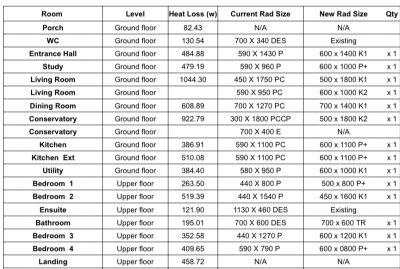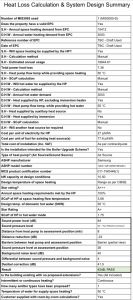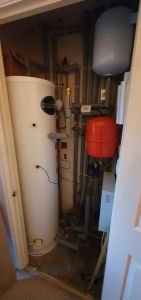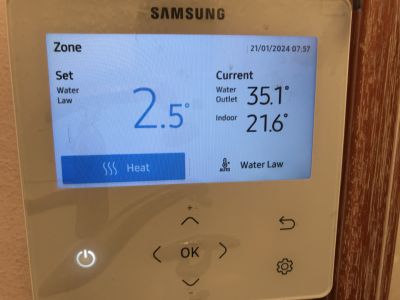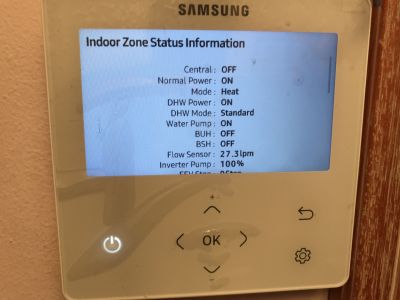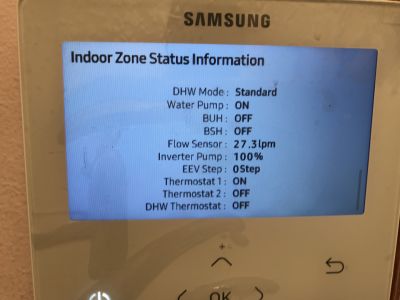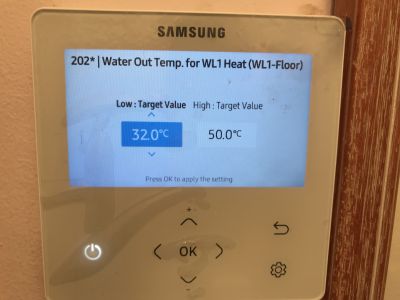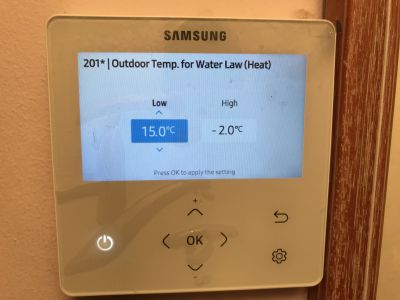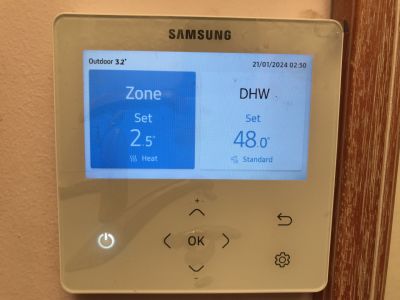12kW Samsung ASHP set up help needed
Hi Everyone,
hoping for some help. I have recently had a 12kW Samsung installed but the installer never returned to do the commissioning. The system was installed with a google nest and all I have done is to input a temperature schedule and left it to do its thing.
Temperature is set at 20 during the day and increased to reach 22 by 7am overnight as I’m on Economy 7.
I have also installed solar panels with battery storage since the ASHP installation.
My energy bills have sky rocketed and wiping me out. I have attached photos from my loop account for reference.
My instantaneous power consumption has never been below 3.5kW for the times I have checked.
Is there a simple guide to follow for setting up the system and commissioning please? I have watched YouTube videos to input some information in field settings but grateful for further guidance.
They system cycles a lot and I am also wondering whether to disable the nest and let the wired control manage the heating?
Thanks in advance.
Hi @swanny , I am sure you will get help here as I have learnt quite a bit from other Samsung users on the forum. We will need a bit more information first. How large is your home and how well insulated? Do you have radiators or UFH and if radiators are they appropriately sized? Type K2 and K3 radiators are the norm for heat pumps. Did your installer give you the results of a heat loss survey?
There are a few different ways of running the Samsung:
1. Weather compensation: this is called Water Law in Samsung speak and means the water from the ASHP will be hotter when outside temp is lower and cooler when it is warmer outside. This is the best mode, but the settings may need adjusting. You can tell if you are in this mode as the wired controller display says Water Law in the bottom right corner and the number on the left is between -5 and 5 (3 in the photo - this is the 'Offset'). In this mode it is best to set any thermostats to a high temperature eg 25 or more to allow the ASHP to run constantly. The weather compensation settings can be changed by going into service mode, but in the first instance it is easier to change the offset to keep your home at your comfort temperature.
2. Room temperature mode: In this mode the adjustable number on the wired controller is your desired room temperature. The ASHP will switch on and off depending on the setting. Weather compensation will be operating in the background, but you cannot change the offset in this mode, just the desired room temp.
3. Fixed water temp mode: The adjustable number on the left of the display will be the desired water temp from the ASHP eg 40
Let us know what mode you are in and we can take it from there. Also pictures of your set up would be good. Do you have a buffer tank as well as a hot water tank?
@mike-h thanks for the prompt response.
I am currently using weather compensation. I don’t entirely understand it but set it up following a YouTube video from a Graham Heat pumps channel. I will bump the temperature up as suggested. Hopefully will not make power consumption worse.
I thought I had included some attachments on the system design but appears not.
@swanny grahams heat pump channel is great for initial setup. however there is a mistake in the weather comp section, he gets two of the temperatures the wrong way round. in one of the videos. surprising really as he's one of the guys who's been doing this for many years professionally.
as mike-h said, post pics of your controller so we know exactly what mode you're in. there are two ways (mikes options 1 and 2) that are sensible. option 3 will cost a fortune (And could be what you have).
My octopus signup link https://share.octopus.energy/ebony-deer-230
210m2 house, Samsung 16kw Gen6 ASHP Self installed: Single circulation loop , PWM modulating pump.
My public ASHP stats: https://heatpumpmonitor.org/system/view?id=45
11.9kWp of PV
41kWh of Battery storage (3x Powerwall 2)
2x BEVs
@swanny Thanks for the heat loss survey. Your heat loss at design temperature (usually around -3.5 deg C) is reported as 7.36, so your ASHP may be oversized. You say that you have a lot of cycling. It is important to distinguish between cycles caused by your thermostat and cycles caused by the radiators emitting less heat than the minimum heat output of the ASHP (around 3.6 - 4kW). The latter occurs when the outside temp is higher and the flow temperature to the radiators is lower. As the flow temperature falls and the room temp rises, a radiator will emit much less heat eg a 600 x 1000 K2 radiator emits 830 watts at a flow temperature of 50 and room temperature of 18. When the flow temperature is reduced to 35, it only emits 350 watts. If your ASHP has been cycling during the cold snap then it is probably the Nest that is switching it off and on. That is really inefficient.
If the lowest power consumption you have seen is 3.5kW, then you do have a problem. Typically, when the ASHP starts up, the power consumption rises to a maximum after 20 mins and then falls over the next 20 mins to a fairly stable level, falling very gradually and slightly as the room temp rises. Eventually, when the heat production and heat delivery matches the heat loss from the home, the room temp will remain constant and so will consumption (unless outside temperature changes or the sun starts heating the house and sundry other variables kick in of course). Below are some snapshots from my 12kW Samsung. LWT is leaving water temp. OAT is outside air temp. Basically, consumption is lower at lower LWT and higher OAT. And LWT falls as OAT rises. The better your house is insulated, the lower you can go with LWT. However, once the Samsung's minimum output is reached, it starts to cycle and becomes less efficient.
I see that Ian has replied to you and he will be able to give you some excellent advice. Please try and send as much information as you can about your set up, including photos. Have you a buffer tank? What are your flow temps, room temp and OAT? Who is your installer?
Very informative responses. Thank you! I think I am using option 1 from Mike’s options above. Screenshot to show this.
I have included more photos for reference.
The house was built in the 80s with retrospective cavity wall and loft insulation added. It also has 5yrs old triple glazed windows.
The installation has a buffer tank in the loft and hot water tank in the airing cupboard on the first floor.
The installer was Greener Living.
@iancalderbank grateful if you could point out which of the water law figures need reversing.
With the kW in figures shown in the table provided by @mike-h, I suspect my set up is not correct. I’d be really happy to get those😀
@swanny If I remember that video correctly from our own Samsun 12Kw pump, he says it rather than types the wrong numbers in, so if you were listening and watching you could get confused.
Your photos show something similar to mine, but our high temperature is at about 42C or so, I need to go and remind myself.
Your flow rate looks interesting, I must go and check ours.
If it is cycling a lot, does the nest thermostat have a cycles per hour setting of some kind? Our system wa installed with a simple Honeywell thermostat which has a cycles per hour setting. The installers left it at 5 so for the first 2 weeks the heat pump was on for 6 mins, off for 6 mins, 5 times an hour. This wasted a lot of power although it did manage to keep the house warm. Then I changed it to 1, ie. it comes on once and hour and runs for up to half an hour and this immediately saved a lot of electricity.
Hello @swanny. I've a 12kW Samsung Gen6 (actually two) so will just add my settings by way of comparison.
After some trialling my weather compensation is set to a max LWT 40°C @ 0°C and min LWT 30°C @ 12°C. I've found that - as long as it's not windy & damp outside - this setting pretty much keeps the house at an even temperature around 19°C. Of course, every house is different and you'll need to have a play with your settings to determine what works for you. That said, your settings do seem high (especially as you're showing a +2.5 offset) so I would guess your system is working very hard and cycling on and off as the Nest is telling it target temperature is being reached. It's generally better to aim for a low LWT with continuous (or near so) heat pump operation.
Bear in mind that it takes a while to establish the right weather compensation line - you'll need to incrementally reduce your settings then monitor for a day or so to see how things fare before making another step. Does your Nest show you a temperature profile? Great if you can see a straight line.
My power consumption is 3kW (and a lot more) at freezing/near freezing temps but even where I am (Cairngorms) that's not too many weeks of the year. For the bulk of the heating season the OATs are typically 5-9°C and, once stable without regular defrost cycles, the heat pump will purr away at between 1-1.5kW under these conditions. Don't despair, you will get there!
2 x 12kW Samsung Gen6 ASHP, 5.6kW solar PV ground mounted c/w 10kWh Puredrive battery & Solis inverter.
Posted by: @swannyWith the kW in figures shown in the table provided by @mike-h, I suspect my set up is not correct. I’d be really happy to get those😀
Hi @swanny , your settings are actually very close to mine and you have them the correct way round, so that's good. To be on the safe side, make sure the settings in FSV 203* is the same as FSV 202*. A room temp of 21.6 and a flow temp of 35 is encouraging too, but I wonder if the flow temp was stable when you took the photo or was on the way up. With your settings the predicted flow temperature would only be 35 if the OAT was 14.5, which I doubt it was. It was 5 deg C in Derbyshire this am. Can you send some more readings when the flow temp is stable, including instantaneous energy use and room temp? You will need to disable your thermostats from switching the heat pump on and off as I suspect these may be the real reason for your high costs as suggested by @guthrie. However, as it is now milder, you may find the heat pump starts cycling for a different reason - because it cannot produce less heat output than the minimum (around 3.5 - 4 kW). There are ways round this if it occurs, but that can wait for now
Another tip to reduce costs is to schedule your DHW heating. Ours heats up once a day. FSV 3032 should be set to 90 minutes instead of the default setting of 20 mins as any use of the booster heater will be expensive.
Greener Living installed mine too. The buffer tank, which the supplier, Freedom Heat Pumps, insists on, was a big issue as it caused the radiator temps to be 4-5 degC cooler than the LWT, so I had to run a higher LWT to get the house warm, which increases cost by 12-15%. The external insulation was very poor and there was no insulation at all where the pipes came through the wall. I had to call them back to fit a strainer filter, which Samsung say is essential. To be fair to them, they did usually come back to fix other less drastic things like leaks and damaged radiators. I would encourage you to be very persistent if you want something done. I have redone the external insulation myself with Insulation Pro and had the buffer tank removed at my own expense
Thank you all for taking time to respond. Looks like I have a lot to learn.
The cycling is indeed as a result of the thermostat calling for heat. I don’t think the ASHP stays on long enough to reach an optimum energy consumption level. The airing cupboard is at a central location so I can hear each time the system comes on with the sound from the groundfos pumps.
@mike-h you are correct - the system had just turned on about 5mins earlier when I took the photo. I am going to get on with some of the suggestions here which will hopefully allow it to run continuously or for longer periods. I will take further photos once I manage to get this done.
I have removed the offset, made minor changes to the water law and increased demand from the thermostat to 25 degrees. Instantaneous energy consumption is has been around 1.2kW which is great but the rads. are not warming up. Although external thermostat is selected for turning on/off and WL pump 1 there is also an indoor temp. set on the wired controller so I will increase this as well and observe what happens.
I will provide further updates. Thanks.🙏
@swanny suggest whilst you are tuning the heating you turn DHW off, or move it to on a schedule, so that it can't call for a dhw cycle in the middle of you watching what the heating is doing. suggest also you reduce the "high" target temperatures to 40C for now, especially whilst its not freezing.
your objective for now is this:
- leave the nest thermostat permanently calling for heat. set it way higher than the actual temperature.
- keep on reducing the running temperature of the heat pump until the house stays at a steady temperature and the heat pump runs continuously for a long period at a stable flow . You reduce the running temp by a) adjusting the WL figures in 202*, but because going in and out of the WL figures every 10 mins is a pain, use the +-5 offset , then once you're more sure of a value, go in and adjust the WL figures. chances are that the high target value will be way to high because your installer overestimated heat loss and so over did the necessary water temp in cold conditions.
- If you have TRV's, remove them. you can put them back in bedrooms and any rooms with large solar gain later.
- If your plumber balanced the radiators, great. if they didn't, thats the next task. Get all radiators carrying enough flow to keep each room warm.
you refer to changing the indoor temp on the wired controller - in the mode you are in that doesn't do anything, in fact there shouldn't be anything to change?
Just double checking ... you don't have a buffer tank or Low Loss Header do you? you said pumps implying more than one often implying a buffer/llh is in the system?
My octopus signup link https://share.octopus.energy/ebony-deer-230
210m2 house, Samsung 16kw Gen6 ASHP Self installed: Single circulation loop , PWM modulating pump.
My public ASHP stats: https://heatpumpmonitor.org/system/view?id=45
11.9kWp of PV
41kWh of Battery storage (3x Powerwall 2)
2x BEVs
Posted by: @iancalderbankJust double checking ... you don't have a buffer tank or Low Loss Header do you? you said pumps implying more than one often implying a buffer/llh is in the system?
Yes he does - If Greener Living source the Samsung from Freedom Heat Pumps, then the buffer tank is required as part of the warranty (personal communication from Fergal at Freedom).
Posted by: @swannyThe installation has a buffer tank in the loft and hot water tank in the airing cupboard on the first floor.
The installer was Greener Living.
- 26 Forums
- 2,418 Topics
- 54.8 K Posts
- 325 Online
- 6,098 Members
Join Us!
Worth Watching
Latest Posts
-
RE: GSHP WOES! Midland based engineer recommendations?
@johnbroome perhaps, does it rise in pressure when heat...
By ASHP-BOBBA , 30 minutes ago
-
RE: Ecodan Pump Issues… Circulation pump turns off when heat pump compressor turns off
can you see here it not like a set of steps every 20 mi...
By ASHP-BOBBA , 32 minutes ago
-
So I hear the export MPAN that UKPN assigned should be ...
By Batpred , 2 hours ago
-
RE: Recommended home battery inverters + regulatory matters - help requested
From what I read, the Solis has a very long list of err...
By Batpred , 2 hours ago
-
RE: Ideal HP290 14kW ASHP - how to optimise
Roughly this should cost you £250-£300 per peak month a...
By ASHP-BOBBA , 3 hours ago
-
RE: Installer Fitted 9kW Instead of 11kW Heat Pump and Changed MCS Paperwork - What do I do?
@jamespa thank you again. I know using the offset to tr...
By MairiA , 4 hours ago
-
RE: New Daikin 11kW Altherma 3M install - is it working as it should?
@toodles Thank you for your input. As the days have got...
By Synthbuilder , 7 hours ago
-
RE: Advice for a novice on Mitsubishi Ecodan 6kW
Frost Protect/Freeze Stat is an operation mode, where D...
By F1p , 7 hours ago
-
RE: Fan unit Making terrible noise HELP!!
@gutoffowc Oh no, sorry to hear that, are you in the Ke...
By ASHP-BOBBA , 9 hours ago
-

RE: Sunsynk Whole House Backup Issue
@sheriff-fatman - could you please re-post that in the ...
By Transparent , 9 hours ago
-
RE: Running my new Nibe ASHP efficiently
I didn't. I spent a while manually messing around with ...
By jamieheatpumpnew , 11 hours ago
-
RE: I’m glad the cold spell is over!
I comparison with the 65kWh used above yesterday was on...
By Judith , 11 hours ago
-
RE: Octopus Cosy 12 Heat Pump Regret: Incredibly Loud, Poor Heating & Constant Hum - Help!
I should think so, I thought that pretty much universal...
By JamesPa , 12 hours ago
-

RE: Setback savings - fact or fiction?
I'm also inclined to look into how a defrost is actuall...
By cathodeRay , 12 hours ago
-
MLCP (Multi-Layer Composite Pipe) for ASHP
@editor nope. The info you reported was sufficient for ...
By iotum , 23 hours ago
-
RE: Experience - New Build / Complete New Heating System
@vincro I would be surprised if it is much above 5 to 6...
By ASHP-BOBBA , 24 hours ago
-
RE: Post-Traumatic Heat Pump Stress Disorder
Yes bang on and maybe I can illustrate that by way of e...
By iotum , 1 day ago
-

